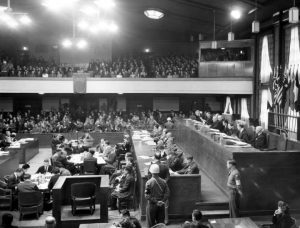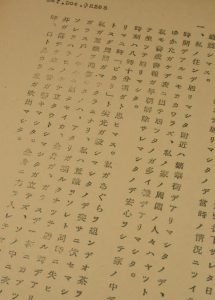Striving to fill voids in Hiroshima, unfinished judgment, Part 2: War crimes trial
Apr. 23, 2024
Testimony about A-bombing experience remains unsubmitted to court
In the International Military Tribunal for the Far East (also known as the ‘Tokyo Trial’), which continued over a period of two-and-a-half years starting in May 1946, judges from the victorious Allied nations in World War II such as the United States, the United Kingdom, and China sat in judgment of Japan’s wartime leaders. Although not a well-known story, the team of defense attorneys were gathering evidence behind the scenes to prosecute a case against the atomic bombings and air raids on cities conducted by the Allied nations.
One piece of such evidence lies untapped at the Kansai University Library in Suita City, Osaka Prefecture. It is an affidavit, or a sworn statement, made by Zenichi Nishimura, who experienced the atomic bombing of Hiroshima. The sworn statement is included in documents involving the Tokyo Trial that were donated by Shoichi Okamoto, a defense attorney who later became a proponent of the idea of a trial in judgment of the atomic bombings.
Seven pages of evidentiary materials
The sworn statement is dated March 30, 1947. Based on an interview with Mr. Nishimura in Hiroshima to learn of the tragedy that occurred in the aftermath of the atomic bombing, the statement is made up of seven pages in the form of documentary evidence for the Tokyo Trial.
The statement included such descriptions as, “I witnessed still-smoldering bodies. I was horrified to find around 40 or 50 bodies of half-burned, naked female students with armbands that read ‘mobilized.’”
Mr. Nishimura was in his 50s at the time. He described how he was still unable to move his fingers freely because the right side of his body had been pierced and wounded by shards of broken glass from the bombing.
This document was put together by someone on the defense team other than Mr. Okamoto. The defense team also set about gathering magazine articles that covered the dropping of the atomic bombs. In shorthand notes taken during the trial is described a debate on March 3, 1947, regarding whether the articles could be introduced as evidence in the trial.
Benjamin Blakeney, an American attorney, requested that the articles be submitted to the court as evidence. Referring to the Convention respecting the Laws and Customs of War on Land (Hague Convention), which restricts indiscriminate attacks and the use of inhumane weapons, Mr. Blakeney argued that the atomic bombings had violated international law. Any such breach of the convention constitutes a war crime.
U.S. prosecutor resists use of materials
One of the U.S. prosecutors resisted the request based on his contention that the materials had nothing to do with the trial. William Webb, the Australian presiding judge, asked how the materials could be considered relevant to the trial even if the atomic bombings had hypothetically been war crimes. Mr. Blakeney challenged the judge, explaining that the right to retaliate to the atomic bombings, a violation of international law, was relevant to the trial of crimes committed since the atomic bombings. Mr. Webb called for a recess and then announced, based on a majority decision made by the judges, his rejection of adoption of the articles.
A hearing for Mr. Nishimura’s sworn statement was conducted 27 days later. With no apparent sign of the possibility of its adoption, it is recorded that the statement was left classified as “unsubmitted.”
Meanwhile, the team of prosecutors submitted large volumes of materials to show the former Japanese military’s breach of international law, such as mistreatment of prisoners of war. In November 1948, the court found 25 defendants guilty, excluding three who had died after their indictment. Seven of the defendants were sentenced to death by hanging.
Later, Mr. Okamoto wrote that the Allied team investigating Japan’s responsibility in illegal acts was “a call for justice,” so long as it was based on fair and impartial reasoning. However, he also felt it was “unfair” that the Allied side was not in any sense being held to account for their own actions, which appeared to represent an extremely grave breach of international law. His anger did not dissipate even after the verdict was handed down by the court.
Keywords
Convention respecting the Laws and Customs of War on Land (Hague Convention)
An international law involving the methods and manners of the conduct of war and military attacks that was adopted in 1899 and revised in 1907. The convention aims at the protection of non-combatants. It prohibits indiscriminate attacks that could lead to damage of non-military targets, except for the case of defensive cities where it is difficult to distinguish military and non-military targets in their attempts to resist occupation by enemy ground forces. Also included in the convention is a prohibition against use of “weapons causing unnecessary suffering.”
(Originally published on April 23, 2024)









